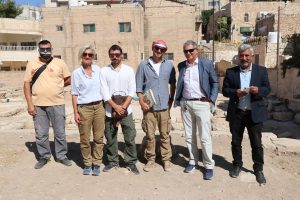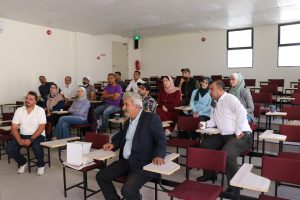


Madaba, 10 october 2021 – Site visit today at the Cathedral Area of Madaba, where the University of Perugia is carrying out archaeological excavations as part of the activities under the “Discovering Madaba: a sustainable tourism project”, funded by AICS in the framework of the interventions on cultural heritage linked to sustainable development.
The Head of AICS Amman Mr Emilio Cabasino joined representatives from the University and project staff working on the site of the Cathedral. This area is one of the largest urban archaeological areas of Madaba, comprising a Byzantine religious complex with large mosaic floors. As the area was in a state of complete abandonment, the project aims to provide the cleaning and restoration of mosaics and structures and extensive archaeological excavations to show the chronological overlapping of the structures, from the Iron Age to the Byzantine Era.
The visit continued to the training courses held at the Madaba Institute for Mosaic Art and Restoration (MIMAR) where the first of 21 specialist trainings on conservation, enhancement and management of cultural heritage and sustainable tourism development are being delivered to a group of 15 people selected from the employees of the Department of Antiquities of Madaba (DoA) and students of the MIMAR.
“Discover Madaba: a sustainable tourism project” is an intervention originated from a specific need of the Department of Antiquities of Jordan to protect and promote the cultural heritage of the city of Madaba, that present problems of conservation and stability of structures, accessibility and proper use for visitors, particularly in some areas of the city. As archaeological sites and historic places are in fact major tourist attraction, and represent a valuable sources of revenue, AICS Amman is supporting Jordan in providing adequate site management to counteract deterioration and enhance valorization of sites to increase their social, historical, educational, and economic potential, as well as raise awareness of shared cultural heritage to boost cultural and archaeological tourism to places of historical significance.
